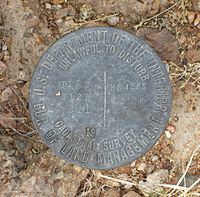Surveying
Main articles: Surveying and Construction surveying
Surveying is the process by which a surveyor measures certain dimensions that occur on or near the surface of the Earth. Surveying equipment, such as levels and theodolites, are used for accurate measurement of angular deviation, horizontal, vertical and slope distances. With computerisation, electronic distance measurement (EDM), total stations, GPS surveying and laser scanning have to a large extent supplanted traditional instruments. Data collected by survey measurement is converted into a graphical representation of the Earth's surface in the form of a map. This information is then used by civil engineers, contractors and realtors to design from, build on, and trade, respectively. Elements of a structure must be sized and positioned in relation to each other and to site boundaries and adjacent structures. Although surveying is a distinct profession with separate qualifications and licensing arrangements, civil engineers are trained in the basics of surveying and mapping, as well as geographic information systems. Surveyors also lay out the routes of railways, tramway tracks, highways, roads, pipelines and streets as well as position other infrastructure, such as harbors, before construction.
- Land surveying
In the United States, Canada, the United Kingdom and most Commonwealth countries land surveying is considered to be a separate and distinct profession. Land surveyorsare not considered to be engineers, and have their own professional associations and licensing requirements. The services of a licensed land surveyor are generally required for boundary surveys (to establish the boundaries of a parcel using its legal description) and subdivision plans (a plot or map based on a survey of a parcel of land, with boundary lines drawn inside the larger parcel to indicate the creation of new boundary lines and roads), both of which are generally referred to as Cadastral surveying.
- Construction surveying
Construction surveying is generally performed by specialised technicians. Unlike land surveyors, the resulting plan does not have legal status. Construction surveyors perform the following tasks:
- Surveying existing conditions of the future work site, including topography, existing buildings and infrastructure, and underground infrastructure when possible;
- "lay-out" or "setting-out": placing reference points and markers that will guide the construction of new structures such as roads or buildings;
- Verifying the location of structures during construction;
- As-Built surveying: a survey conducted at the end of the construction project to verify that the work authorized was completed to the specifications set on plans.



Comments
Post a Comment